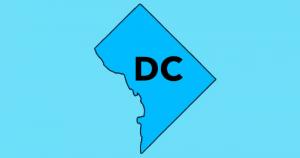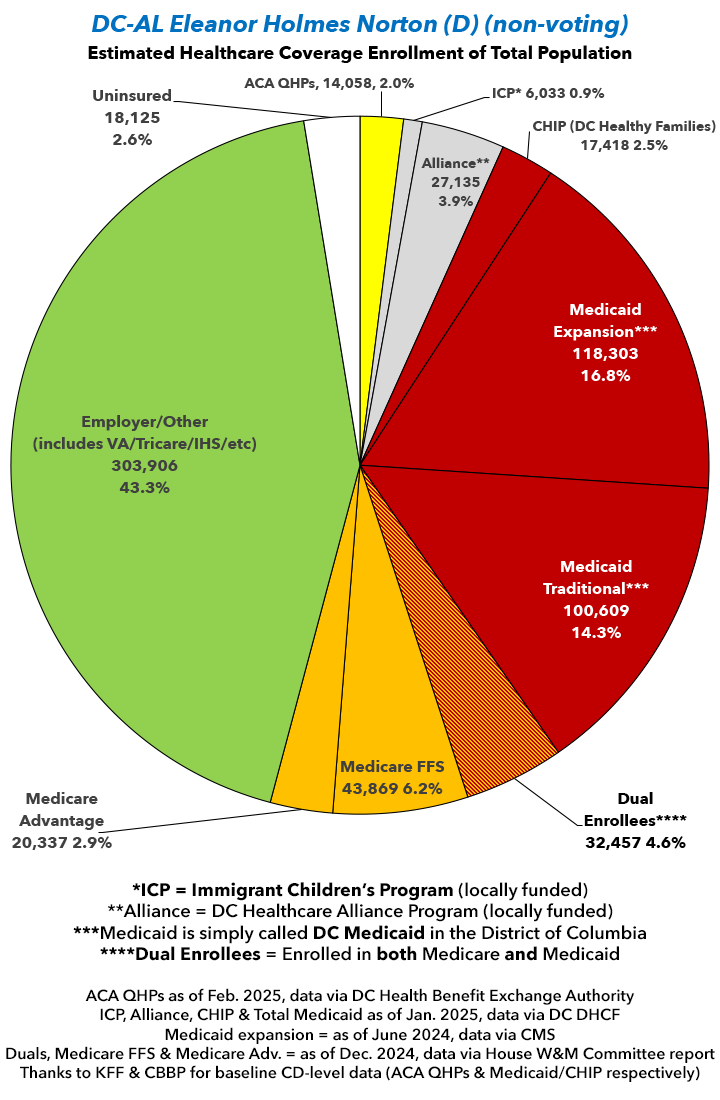District of Columbia: Meet the 2 locally-funded programs covering nearly 5% of DC's total population

I thought I had finally wrapped up my ambitious Congressional district-by-district healthcare program enrollment pie chart project (for all 435 districts...actually 436 w/DC included). I knew I'd still have to update the numbers every few months, but at least the dust had finally settled on the layout and what info I'd include on each graphic.
And then North Carolina Governor Josh Stein announced that the state had broken 650,000 Medicaid expansion enrollees, which made me realize that the enrollment data for some of the categories in the charts is now up to 10 months out of date. While total Medicaid enrollment is pretty recent (as of November 2024), expansion data for most states/districts comes from the CMS MBES report, which has only been updated through last June.
Since I was about to generate the high-def PDF version of the graphic for DC anyway, I decided to check the DC Dept. of Healthcare Finance archives, and sure enough I found this Medicaid enrollment report, which brings the enrollment data up through January 2025.
However, I was surprised to discover that in addition to Medicaid and CHIP (the Children's Health Insurance Program), DC also has two other local healthcare coverage programs, which cover over 33,000 DC residents between them:
The Immigrant Children’s Program is a program designed to provide health coverage to individuals under the age of twenty-one (21) who are not eligible for Medicaid. Services covered under the Immigrant Children’s Program are identical to the services covered under Medicaid for children under age twenty-one (21).
You may be eligible for the Immigrant Children’s Program, if you:
- Are under the age of twenty-one (21)
- Are a District resident;
- Are not eligible for Medicaid; and
- Have income at or below 200% of the FPL
*There is no resource test for the Immigrant Children’s Program.
- The District covers this population with household income up to 319% of the Federal Poverty Level
There's currently around 6,000 DC residents enrolled in the ICP.
The DC Healthcare Alliance Program (“the Alliance”) is a locally-funded program designed to provide medical assistance to District residents who are not eligible for Medicaid. The Alliance program serves low-income District residents who have no other health insurance and are not eligible for either Medicaid or Medicare.
To be eligible for the DC Healthcare Alliance, you must be a resident of the District of Columbia, meet financial eligibility requirements, and not have any other health or medical health coverage.
You may be eligible for DC Healthcare Alliance if you:
- Are twenty-one (21) and older;
- Are a District resident;
- Have income at or below 210% of the federal poverty level (“FPL”) ( see chart below) plus a 5% income disregard;
- Have no health insurance, including Medicare and Medicaid.
The District covers this population with household income up to 210% of the Federal Poverty Level
There's currently around 27,000 DC residents enrolled in the DC HAP...which is actually nearly twice as many as are enrolled in DC ACA individual market exchange policies.
Anyway, I just figured that since I've never heard about either of these programs that most other folks hadn't either, so it was worth a shout-out.
Here's more information about both of these programs:
With limited exceptions, undocumented residents and recent green card holders are not eligible for federally funded health insurance programs (e.g., Medicaid and Medicare). However, in order to provide health care to those in need regardless of immigration status, the District of Columbia created two locally funded health insurance programs: the Immigrant Children’s Program (ICP) and the DC Health Care Alliance (the Alliance). There are no monthly premiums, copayments, or other charges for covered services for the Alliance and ICP.
...The District’s FY25 budget includes $132.6 million for Alliance and $18.3M for ICP provider services. As of November 2024 (the most recent available data), the Alliance enrolls 26,370 District residents and ICP enrolls 5,871 District residents. Enrollment has shifted significantly over the past few years, increasing – like all public health insurance programs – during the COVID-19 public health emergency, because from 2020-2022 the District removed almost no residents from either program, removed certain enrollment barriers, and allowed new people to join. In August 2022, enrollment plummeted to pre-pandemic levels when annual recertification processes resumed. The programs have now returned to high participation numbers – higher than peak pandemic enrollment – thanks in part to enrollment reforms, more programmatic awareness among eligible populations, and an increase in immigrants making the District their home.




